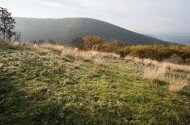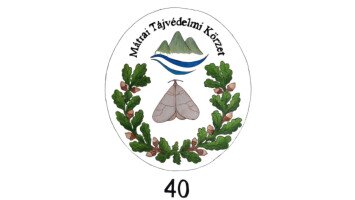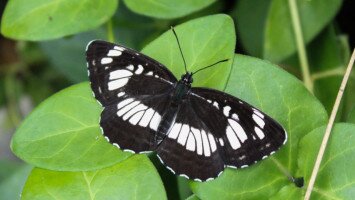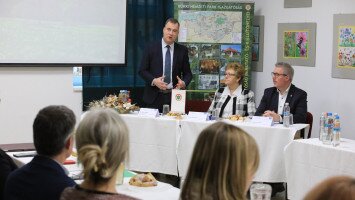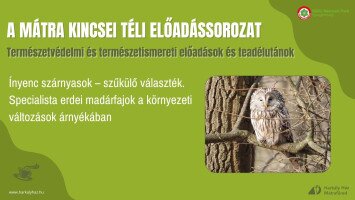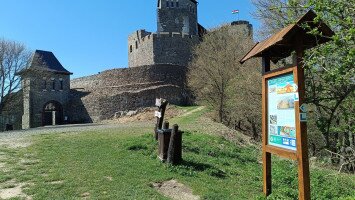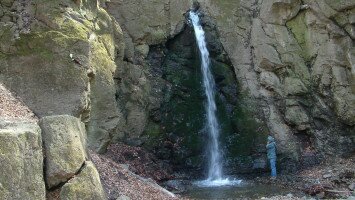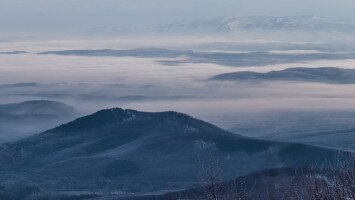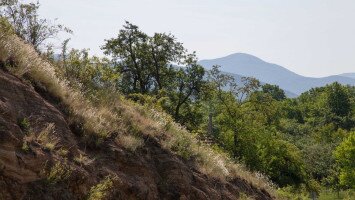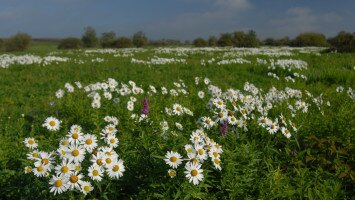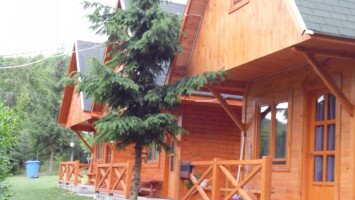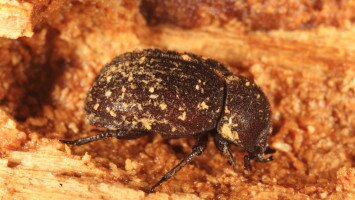
Védetté nyilvánítása: 1985
Területe: 11 841 ha
A tájvédelmi körzet alapadatai
Az 1985-ben védetté nyilvánított Mátrai Tájvédelmi Körzet mintegy 12 000 hektáros területen jött létre nagyobb részt Heves-, kisebb részben pedig Nógrád-megyében. A hegység kisebb nyugati, és nagyobb keleti részét foglalja magában, kikerülve a forgalmas lakó- és üdülő településeket. A kisebbik Ágasvár környéke, a Mátrabérc még védelemre érdemes része, a másik a Kékes tömbje a Keleti – Mátrával, viszonylag nagyobb, összefüggő, természeti értékekben gazdag terület. A tájvédelmi körzet 12 település közigazgatási területét érinti (Bátonyterenye, Domoszló, Gyöngyös, Gyöngyössolymos, Kisnána, Markaz, Mátraszentimre, Parád, Parádsasvár, Pásztó, Recsk, Sirok).
Földrajzi jellemzők, földtani felépítés, vízrajz
A hegység éghajlata különleges földrajzi helyzete és domborzati viszonyai miatt meglehetősen eltér az országos adatoktól. A viszonylag nagy relatív szintkülönbségek (400-900 méter) miatt az éghajlat mérsékelt égövi – hegyvidéki jellegű. A mikroklíma mozaikok a hegység viszonylag erős vízszintes és függőleges tagoltsága miatt alakulnak ki, az erdős terület hatása teszi még változatosabbá ezeket. A kedvező klimatikus viszonyok a hegységben jelentős gyógyászati – gyógyüdülési lehetőségeket kínálnak, melyet az 1930-as években épített gyógyüdülők – Kékestető, Mátraháza, Parádfürdő – ki is használnak
Az Észak-magyarországi-középhegység részét képező Mátra a Kárpátok belső vulkáni övezetéhez tartozik. A hegység fő tömegét a miocén kori (20–13 millió éves), nagyobbrészt andezit, andezittufa és andezit agglomerátum váltakozásából álló, több száz méter vastag rétegvulkáni összlet képezi, melyet aztán a szerkezeti mozgások jelentősen átszabtak. Az egész vulkáni tömb már működésének korai szakaszában dél felé megbillent, és féloldalasan emelkedni kezdett. Végül a felszínformáló erők pusztító hatására alakult ki mai jellegzetes morfológiája. A vulkanikus kőzetből a hegytetőkön helyenként merész sziklaformák preparálódtak ki. A sziklafalak, kőbástyák, előterükben a durva törmelékből álló törmelékmezők, kőtengerek a jégkorszak során alakultak ki, a fagy kőzetaprózó hatására. A Csörgő-lyuk hazánk leghosszabb (370 m) nem karsztosodó kőzetben kialakult barlangja. A vulkáni működés szüneteiben és lezárultát követően erős vulkáni utóműködés zajlott, amelynek során gazdag érctelepek keletkeztek Gyöngyösoroszi, Mátraszentimre, illetve Parád és Recsk térségében. A vulkáni utóműködésnek köszönhetően a hegységben sok kén-hidrogénes, szén-dioxidos forrás, ún. csevice tör fel a felszínre. Ilyenek a parádfürdői Szent István-forrás (Ilona-völgy), a parádóhutai Klarissza-forrás, a Mátraderecske és Parádsasvár térségében lévő források.
A Mátra forrásokban, patakokban gazdag, mintegy 360 forrást ismerünk. Vízhozamuk változó, nagyban függ a csapadék mennyiségétől és 47 forrás hozama éri el a 10 l/perc mennyiséget. A hegység nyugati és keleti határának tekinthető két folyó, a Zagyva és a Tarna számos mátrai vízfolyás vizét szállítja a Tiszába. A Mátrából ered a Zagyvának 62, a Tarnának 46 mellékága. Ezek képezik a terület kisvízfolyásait.A kisvízfolyások többségére a nagy esés jellemző. A tavaszi hóolvadás és a nyári záporok alkalmával nagy mennyiségű hordalékot szállítanak, száraz időben egy részük pedig kiszárad
Társadalmi jellemzők
A Mátra a közlekedés szempontjából jól feltárt területnek tekinthető. Mind a Gyöngyös – Parád közötti, mind pedig a Mátraháza – Galyatető – Hasznos közötti közúton jelentős forgalom bonyolódik. A hegyi települések, a „szent falvak” (Mátraszentimre és résztelepülései) lakossága elsősorban a turizmusra alapozzák megélhetésüket, ezért az itt jelentkező fejlesztési igények, elképzelések jelentős terhet rónak a természetvédelmi kezelőre.
Gazdálkodás
A Mátra legmeghatározóbb gazdálkodási ága az erdőgazdálkodás. Az itt található erdőkre különösen a középkortól kezdve az emberi igények kielégítése nyomta rá bélyegét. A tűzifa, épületfa, szerfa igényen túl az üveggyártáshoz szükséges hamuzsír előállítás eredményezte sok helyen a jelenlegi erdőkép (nagy, egybefüggő, egykorú, szintezettség nélküli erdők) kialakulását. A déli peremterületeken gyümölcstermesztést, legfőképpen szőlőművelést folytatnak. A század elején nehéz fizikai munkával, kézi kapával irtották végezték a művelést, illetve a szőlő betakarítása, és sajtolása is kézi erővel történt. A gépesített szőlőművelés megváltoztatta a szőlőterületek képét. A kisparcellás művelést felváltotta a nagyüzemi gazdálkodás. A Dél-Mátra települései (Markaz, Domoszló, Kisnána) elsősorban a szőlőterületekre alapozott gazdasági lehetőségeit, a falusi- és a borturizmust aknázzák ki. Az állattenyésztést a Mátra északi oldalán elsősorban a szarvasmarha, míg a déli oldalon juhtenyésztésre alapozták. Napjainkban a védett területen a természetvédelmi kezelés részeként csak a Bükki Nemzeti Park Igazgatóság végez legeltetéses állattartást kárpáti borzderes szarvasmarha fajtával.
Természeti értékek
Botanika
A Mátra erdős táj, változatos erdőtársulásokkal. Legjellemzőbb erdőtársulásai a cseres – tölgyes erdők. A cseres – tölgyeseket északon 550 m, délen 650 m magasság körül gyertyános – tölgyes, majd bükkös váltja fel. 900 m fölött magashegyi bükkös található Kékes, Galyatető, Piszkéstető északi lejtőin. A Mátra északi hűvös lejtőin több magashegységi faj talál életteret. A legszebb, montán bükkös erdőtársulás a Kékes északi oldalában sok ritka növényfajnak ad élőhelyet. Az itteni idős, természetközeli állapotban lévő bükkösben jelölték ki a hegység két erdőrezervátumának egyikét, ahol a változatos faállomány-szerkezet és a természetes erdődinamikai folyamatok teljes ciklusban vizsgálhatók Itt él a piros virágú, tüske nélküli havasi vagy bérci rózsa (Rosa pendulina), a pávafarkú salamonpecsét (Polygonatum verticillare) Az északi oldalakon hársas törmeléklejtő erdők és szurdokerdők jelzik a sajátos mikroklímát. Növényritkaságuk a poloskavész (Cimicifuga europaea), a kék virágú, nyáron nyíló havasi iszalag (Clematis alpina), a köves helyeken jellemző erdei holdviola (Lunaria rediviva), vagy a hármaslevelű macskagyökér (Valeriana tripteris). Több védett páfrányfaj él itt, a szőrős vesepáfrány (Polystichum braunii), a karéjos vesepáfrány (Polystichum aculeatum), és a hazánk területén csak itt élő havasi szirti páfrány (Woodsia alpina).Az északra kinyúló gerinceken a jégkori reliktumnak tekinthető lila csenkesz (Festuca amethystina) él. Legközelebbi élőhelye a Budai – hegység, itt az északkeleti hegyvidéken másutt nem is található. A sziklák repedéseiben az áttelelő levélzetű, alig 10 cm-es északi fodorka (Asplenium septentrionale), a szürke levelű, fehér vagy rózsaszínes pártájú, 30 cm körüli magasságú fürtös kőtörőfű (Saxifraga paniculata), a sárga kövirózsa (Jovibarba hirta) és a varjúháj fajok telepednek meg..A Mátrában csak a Gazoskő sziklafalán fordul elő az alacsony termetű sziklai ternye (Alyssum saxatile). A vékony termőtalajú andezitsziklákon nyílt sziklagyep alakul ki, a vastagodó talajon fokozatosan záródó sziklagyep nő a sziklai csenkesz (Festuca pseudodalmatica) és a magyar perje (Poa pannonica subsp. scabra) állományaival. A sziklagyep társulások gyöngyvesszős cserjésekkel szomszédosak. A névadó növény, a szirti gyöngyvessző (Spiraea media) 1 méter magas, nehezen áthatolható bozótokat alkot, melyben a mátrai madárbirs (Cotoneaster matrensis) is otthonos. A régi erdőirtások helyén legelők, majd kaszálók, mára pedig fajgazdag hegyi rétek, vörös csenkeszes, háromfogfüves, szőrfüves gyepek, kékperjés láprétek alakultak ki. Itt fordul elő többek között a kornistárnics (Gentiana pneumonanthe), a fekete kökörcsin (Pulsatilla pratensis subsp. nigricans), szibériai nőszirom (Iris sibirica) és a gömböskosbor (Traunsteinera globosa). A forráslápok, valamint az azokat kísérő kisvízfolyások védett különlegessége a hegyi perje (Poa remota), amelynek valamennyi hazai előfordulása Mátrában található, a Galya déli előterében, illetve a Kékes tömb északi lábánál. Szintén ezekhez az élőhelyekhez kötődik a hússzínű ujjaskosbor (Dactylorhiza incarnata), az erdei ujjaskosbor (Dactylorhiza fuchsii) és a sugárkankalin (Primula elatior). Tavaszi időszakban vízzel borított cseres tölgyesben a kockás liliom (Fritillaria meleagris) él egyetlen mátrai élőhelyén.
Zoológia
A csigák közül egyes ritka fajok a jégkori klíma emlékét őrzik: hideg mikroklimatikus zugokban maradtak fenn, túlélve a melegebb, szárazabb periódusokat. Ilyen faj például a barna korongcsiga (Discus ruderatus), amely az öreg hegyvidéki bükkös egyik jellemző csigafaja. A magasabb rendű gerinctelen állatok terén a leglátványosabbak a nappali lepkék. Hazánkban, a Mátra patakvölgyeiben éri el elterjedésének határát a keleti gyöngyházlepke (Argynnis laodice). A Mátrától nyugatra már nem fordul elő ez az elegáns lepkefaj. A száraz sziklai cserjések dekoratív nappali lepkéje a nagy fehérsávoslepke (Neptis rivularis). Tápnövénye a szirti gyöngyvessző (Spiraea media). Az éjszakai lepkefajok közül fokozottan védett Anker-araszoló (Erannis ankeraria) említhető meg, melynek legerősebb magyarországi állománya a Mátrában található. Lepkefaunánk érdekes tagja a melegkedvelő tölgyesekben előforduló zörgőbagoly (Rileyiana fovea), mely repülés közben jellegzetes pirregő hangot hallat. A Mátra hideg vizű kis vízfolyásaiban fejlődik a hegyi szitakötő (Cordulegaster bidentata) lárvája. A fekete-sárga színezetű imágó azokat a 700 méter fölötti szakaszokat kedveli, ahol az erdő a patak fölött összezárul. A holt fához kötődő bogárfajok közül a fokozottan védett remetebogár (Osmoderma eremita) vagy a kék pattanó (Limoniscus violaceus) előfordulását fontos kiemelni. A Mátra kétéltű fajai közül a fokozottan védett alpesi gőte (Triturus alpestris) vagy a sárgahasú unka (Bombina variegata), az erdei- és gyepi béka (Rana dalmatina, R. temporaria) és látványos foltos szalamandra (Salamandra salamandra) érdemel említést. A Mátra legértékesebb, legkisebb termetű hüllőfaja pedig a pannongyík (Ablepharus kitaibelii), mely a kevésbé zárt melegkedvelő tölgyesekben vagy bokorerdőkben talál élőhelyet.
A nagy területű, zárt erdőknek, illetve a környező peremterületeknek igen gazdag a madárvilága. A fészkelő fajok listáján több fokozottan védett faj szerepel. A legnagyobb európai sasok egyike a parlagi sas (Aquila heliaca), mely féltve őrzött fészkelő madarunk. A kisebb termetű kis békászósas (Aquila pomarina) is szórványosan fészkel. A közönségesnek mondható egerészölyv (Buteo buteo) mellett szórványosan fészkel a darázsölyv (Pernis apivorus), és a ritkább kígyászölyv (Circäetus gallicus). A baglyok közül az uhu (Bubo bubo) és az uráli bagoly (Strix uralensis) képviseli a legnagyobb eszmei értéket. Holt fában gazdag bükkösök ritka madárfaja a fehérhátú fakopáncs (Dendrocopos leucotos). Értékes színfoltja az összefüggő, zárt, háborítatlan idős erdőknek a fekete gólya (Ciconia nigra). A Mátrában számos védett emlősfaj is élőhelyet talál. Az idős, lombos erdők korhadt fatörzseiben talál menedéket számos denevérfaj, ezért az erdőgazdálkodás során ezen faegyedek kiemelt védelme szükséges. Fontos élőhelyet jelentenek a Mátrában az érckutatások után visszahagyott bányavágatok, tárók. Itt található az Északi-középhegység egyik jelentős hosszúszárnyú denevér (Miniopterus schreibersi) állománya, amely mintegy 3-4000 példány közönséges denevérrel (Myotis myotis) alkot kolóniát.
Kultúrtörténeti értékek
A Mátra és környéke már az időszámításunk előtti korokban is lakott volt. Ennek bizonyítékai a főleg a Mátra déli lábánál fekvő települések közelében feltárt kő, réz és bronz eszközök. A Mátrában számos helyen találhatunk a bronzkor korai, középső és kési szakaszából származó erődített telepet, őskori földvárat (pl. Ágasvár, Óvár). A későbbi korból fontos lelet a Gyöngyösön 1907-ben feltárt i.e. IV. századi szkíta urnatemető és a nagyrédei nagykiterjedésű avar temető. A középkor az intenzív várépítések időszaka volt. Ezek közül a várak közül több is a korábbi, őskori várak területére települ. A legkorábbi várról, mely Gyöngyöspatán volt, a 13. században keletkezett Anonymus-gesta tesz említést, viszont számos, a régészeti leletek alapján szintén az Árpád-korra datált várról nem rendelkezünk írásos emlékkel. A 14-15. századtól kezdődően már számos oklevélben találhatunk utalásokat a mátrai várakról (pl. Oroszlánvár, Hasznos, Bene), melyek jelentősége a török hódoltság időszakában fokozatosan lecsökken. Falaikat az 1700-as évektől a környékbeli települések lakossága építőanyagnak fokozatosan elhordta, ezért napjainkban alig néhány helyen találhatunk falmaradványokat.
Gyakorlati természetvédelem
Élőhelykezelések
A Mátrában a természetvédelmi kezelési feladatok közül talán a hegyi rétek kezelése a legjelentősebb. A hegyi rétek kialakulása antropogén eredetű, a 200-250 évvel ezelőtti erdőirtások nyomán keletkeztek, amikor is az erdők faanyagát nagyrészt az üveghuták használták fel, majd a kialakuló vágásterületeket kaszálással vagy legeltetéssel hasznosították. Mátraszentimre és Parád települések közigazgatási területén, nagyjából 60 ha területen végzünk gyepkezelési (rekonstrukciós és fenntartási) munkálatokat. Ezek a munkák különböző fázisban vannak, bizonyos területeken a kézi és gépi bozótirtás után még szárzúzás folyik. Más területek viszont már alkalmasak arra, hogy rajtuk kaszálni lehessen. A Parádon található élőhelykezelési központ környékei gyepek fenntartása pedig legeltetéssel történik.
Az igazgatóság vagyonkezelésében lévő őshonos erdőállományokban csak a szerkezeti változatosság növelése érdekében végzünk beavatkozásokat, ezzel szemben az idegenhonos fafajú erdőterületen megkezdődött azok átalakítása, őshonos fafajokkal történő lecserélése.
Fontos részét képezik feladatainknak az agresszíven terjedő, invazív fajok visszaszoírtása, részben mechanikai módszerekkel (akár évente többszöri kaszálás pl. a hibrid japán keserűfű esetben), részben vegyszeres védekezéssel (akác fúrásos-injektálásos kezelése).
Fajvédelem
A Mátrában számos jelentős kétéltű szaporodóhelyet ismerünk. Fontos, talán a legfontosabb szaporodóhelyek a mátrai víztározók (csórréti, hasznosi, köszörű-völgyi). Kétéltűfaunájukat az Északi-középhegységben általános elterjedésűnek számító fajok (pettyes gőte, barna varangy, gyepi béka, erdei béka, levelibéka) határozzák meg. A gépjármű forgalom miatt bekövetkező pusztulások elkerülésére hosszú távú megoldásként beton terelőárkok, illetve kétéltű átjárók kiépítésére került sor 2015-ben a közutak mentén Sás-tón, illetve Hasznoson.
A gyakorlati madárvédelem régi, jól bevált módszere a költőodúk, költőládák kihelyezése. A természetes fészkelőhelyek megfogyatkozásával sok faj számára csak ezzel a módszerrel tudjuk elősegíteni az állománycsökkenés visszaszorítását. A program részeként énekesmadár, különböző bagolyfajok, illetve szalakóták megtelepedését segítjük elő odúk, a nagytermetű ragadozómadárfajok számára műfészek kihelyezésével.
Részben a földtani értékek védelmét célozzuk meg a Mátrában található bányatárók megőrzésével, illetve rekonstrukciójával, azonban ez egyben az itt élő denevérkolóniák élőhelyének biztosítását is szolgálja.
Természetvédelmi problémák
A Mátra jelenlegi erdőképének kialakulása az emberi beavatkozás eredménye. A üveghuták, faszénégetés, hamuzsírfőzés következtében egyre nagyobb mennyiségű faanyag került kitermelésre, ami a biológiai sokféleség és erdőterületeink csökkenéséhez vezetett. Napjaink vágásos üzemmódú erdőgazdálkodása sajnos még mindig elsősorban a gazdasági érdekeket tartja szem előtt, ami erős ellentétben áll a természetvédelmi törekvésekkel. Kisebb-nagyobb területeken azonban már több helyen – a Mátrában például a parádi erdőtömbben – folytatnak természetközeli gazdálkodási módokat. A cél ezeken a területeken a folyamatos erdőborítás biztosítása, melynek lényege, hogy a természetes újulat megjelenését és növekedését felhasználva, fokozatos lékes bontásokkal kezelik az erdőket, teret hagyva a természetes folyamatoknak, a helyenként összeroskadó, majd megújuló erdőfoltok dinamikus működésének, valamint a holt faanyagot, változatos élőhelyet kedvelő élőlényeknek. Jelenleg az egyik legnagyobb problémát a vágásos erdőgazdálkodási mód mellett a túltartott vadállomány jelenti, mely az érzékeny élőhelyekre és növényekre gyakorolt káros hatása (túrás, taposás, lerágás) mellett akadályozza a természetes erdőfelújítási módszereket, illetve nagyban hozzájárul egy szintén káros folyamathoz, az inváziós növények terjedéséhez, sőt egyes helyeken a talaj pusztulásához, ezzel együtt a szó szoros értelmében akár fák kidőléséhez is.
A turisztikai beruházások (síközpont fejlesztések, hóágyúzás negatív hatásai, stb.), az egyéb beépítések növekvő területfoglalásai, a különféle technikai sportok és a túlzott mértékű, koncentrált turizmus is egyre nagyobb veszélyt jelentenek a még megmaradt természetközeli élőhelyekre.
Kutatás, oktatás
A Mátra természettudományos feltárása mintegy három évszázados múltra tekint vissza. Az első írásos említés Heves-megye aranybányászatáról 1700-ból származik. Részletesebb geológai és az élővilágra vonatkozóan adatokat Bél Mátyás Heves-megyét ismertető munkájában (1730-1735) találunk. Az 1800-as évekből fontos megemlítenünk Kitaibel Pál nevét, aki utazásai során többször is járt a Mátrában. Naplói mind a földtani értékekkel (ásványok, gyógyvizek), mind pedig a növény- és állatvilággal, sőt a gombákkal kapcsolatban is szolgáltatnak adatokat. A Mátra részletesebb botanikai és zoológia vizsgálata a 20. század első felétől indul, 1977 tavaszától pedig „Az Északi középhegység természeti képe” program keretében 34 kutató részvételével kezdődik meg táj részletes kutatása. A Bükki Nemzeti Park Igazgatóság 2006-tól elkezdte védett területek vegetációtérképének elkészítését, mely a természetvédelmi kezelést megalapozó kutatások része.
Napjainkban számos, korábban nem vagy kevéssé vizsgált, elsősorban gerinctelen csoporttal kapcsolatban végzünk részletes kutatásokat, melyek amellett, hogy újabb fajok megtalálását eredményezik, hozzájárulnak a természetvédelmi kezelési javaslatok, előírások kidolgozásához. A xilofág és szaproxilofág bogár fajok közt sok a jelentős természetvédelmi értékkel bíró faj. Ezek mind a különböző európai, mind pedig a hazai védettségi listákon nagy számban szerepelnek. A 2009. óta végzett vizsgálatok célja e fajok adatainak gyarapítása, a kapott adatok alapján az erdőtervezésekhez adott természetvédelmi kezelési javaslatok kidolgozása. A kutatások megerősítették, hogy e fajok megőrzéséhez többek között az idős erdőállományok, sok, a korhadás különböző fázisaiban lévő holt fa, az elegyfafajok jelenléte is szükséges. Az utóbbi években megindultak a Mátrában a talajzoológiai vizsgálatok is, melyek részben a pók-, illetve a futóbogár fauna feltárását, részben pedig a védett területen történő legeltetés monitorozását célozzák meg. Az ízeltlábúak közül említés érdemel még a lepke-, egyenesszárnyú- és szitakötő fajok vizsgálata is.
A természetvédelmi kezelés részeként a jelentős szerepet vállalunk a környezeti nevelésben, szemléletformálásban, ismeretterjesztésben. Jeles napjainkon (Madarak és Fák Napja, Föld Napja, stb.) különböző tematikus előadásokkal várjuk az érdeklődőket, illetve veszünk részt rendezvényeken, iskolákban. Igény esetén túravezetéseken, illetve az Igazgatóság által meghirdetett nyílt napokon mutatjuk be a tájegység természeti értékeit
Látogathatóság
A tájvédelmi körzet egész területe a jelzett turistautakon szabadon látogatható, azonban a fokozottan védett területeken haladó jelzésekről tilos a letérés. Egyes kiemelt értékkel bíró élőhelyek csak az igazgatóság külön engedélyével látogathatók. A tájvédelmi körzeten átvezető közutak gépjárművel korlátozás nélkül használhatók. Az egyéb szilárd burkolatú és földutak az erdészetek üzemi útjai, azokon csak a természetvédelmi hatóság és az illetékes erdészetek engedélyével szabad közlekedni. Kerékpárral a jelzéssel ellátott erdei kerékpáros utak használhatók.
